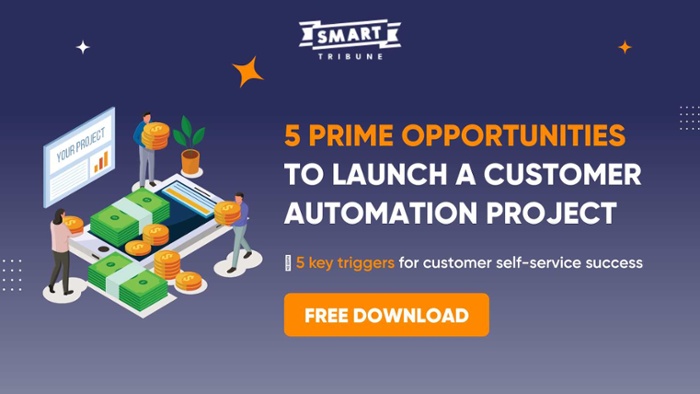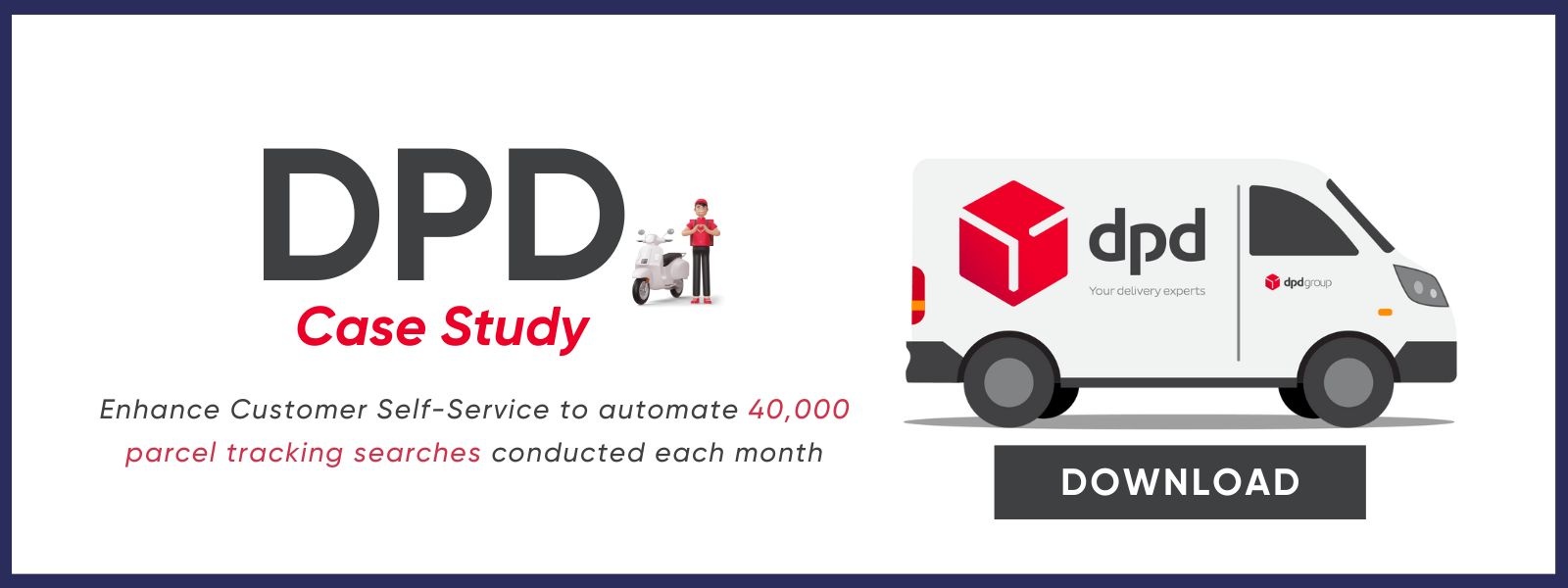
On AUGUST 25, 2020
The Best Customer Self-Service Channel: Dynamic FAQ or Chatbot?
In the realm of customer self-service, there always seems to be two camps: companies that prefer dynamic FAQs and others that favor chatbots. But the reality is that these solutions aren’t mutually exclusive; when combined, they can deliver a truly enhanced customer service experience that drives meaningful long-term results.
However, whether you choose to go in one direction or the other—or ultimately decide to implement both customer self-service solutions—it’s not always clear where to start. That’s why the experts at Smart Tribune decided to shed a little light on the issue to help you determine what solution(s) can best address your business’s unique customer service needs.
Understanding a big part of the customer self-service ecosystem
What is customer self-service?
As mentioned before, customer self-service is all about giving your customers a variety of ways to get immediate answers to their questions on their own—at any time of day, on any device, and in whatever format is most convenient for them to use at any given point in time. Both dynamic FAQs and chatbots are a part of this customer service ecosystem that seeks to make customers as autonomous as possible at every step along their experience with your brand.
There are a number of key benefits to customer self-service, including:
- Reduced contact rates into your contact centre
- Improved customer satisfaction
- Increased conversions
What is a dynamic FAQ?
A dynamic FAQ is the latest iteration on the tried-and-true static FAQ page. The goal of a dynamic FAQ is simple: to help customers find immediate responses to up to 80% of their most frequently asked questions by making all the information within your knowledge base easily accessible via an intuitive and easy-to-use help centre that’s well-integrated throughout your website, mobile site, and mobile app.
Unlike on a static FAQ page, customers no longer have to scroll endlessly to find the information they need. Questions and answers within a dynamic FAQ are organized into semantic groups and powered by both artificial intelligence (AI) and machine learning for improved searchability and relevance. All in all, this creates a better, faster, and more enjoyable customer experience.
What is a customer service chatbot?
A chatbot, on the other hand, is an automated virtual assistant, embedded in your website or on third-party messaging apps, that can carry out customer service-based conversations with customers via natural language processing.
They, too, use AI to identify the best responses to customer questions—based on the information stored within your knowledge base—and leverage machine learning to learn how to respond to customers in more relevant and useful ways over time. For this reason, chatbots are seen as the future of customer service.
The state of customer self-service solutions in Europe today
All stats point to the fact that customer self-service solutions are on the rise. This is true for both dynamic FAQs and chatbots. As of today, 44% of brands have either a knowledge base or FAQ solution implemented on their websites, with 66% of those with knowledge bases installed saying that it’s easier to search for information with these solutions.
Additionally, in light of AI being the latest tech trend catching practically everyone’s attention right now, it’s been shown that 39% of European companies today are now interested in investing in chatbot technology to power their customer experiences.
Another 66% of companies are interested in using this technology specifically to expand how they manage customer service requests down the road.
However, the benefit of customer service chatbots for businesses doesn’t yet see eye-to-eye with customer expectations: a whopping 92% of European consumers say they would be frustrated with interacting with a chatbot, especially for handling after-sales customer service requests.
For this reason, there’s still a way to go before customer service chatbots reach the same level of adoption—and customer appreciation—as FAQ solutions (both static and dynamic).
Mapping customer self-service solutions to customer needs
Although all customer self-service solutions can provide incredible value to both brands and customers alike, the decision of which solutions to implement must ultimately come down to one thing: what will best address your customers’ needs. Here are two key trends to keep in mind as you work through this:
Today’s customers are more independent than ever before
According to Forrester, 72% of customers prefer solving problems on their own, without having to contact customer support for help. This is even more reason why brands must seek new ways to provide their customers with the right information at the right time at every step along the customer journey.
Simplifying the customer experience with automated actions
Because AI and machine learning form the backbone of customer self-service solutions, they create new ways for brands to automate both information-finding and other basic tasks that create a smoother and more pleasant customer experience.
What tasks a brand decides to automate, however, can help determine which customer self-service solution is the best fit for delivering that information:
- If a customer wants to find business-level information (i.e. “How can I track my package status?”), businesses can easily provide this general information via a dynamic FAQ.
- If a customer wants to find account-level (personal) information (i.e. “Where can I download my banking details?”), these can be handled by one-to-one customer service chatbot interactions, as chatbots have direct access to the information housed within a customer’s profile (once authenticated, of course!).
When in doubt, start with a dynamic FAQ
The primary goal of a dynamic FAQ is to centralise, streamline, and increase access to all the information housed within your knowledge base. Enhanced and intelligent search functionalities also make it easier for customers to access the information they need, quickly, easily, and in real-time.
Additionally, solutions like Smart FAQ add a powerful SEO layer to your knowledge base content, making it even easier for customers to find the information they need directly via the search engine results page.
In fact, there are some immediate improvements to the customer experience that stem from this:
- Customers are eight times more likely to take action (convert) when accompanied by customer self-service solutions like a dynamic FAQ.
- Typically, customers are much happier when they can find answers quickly and easily.
- Dynamic FAQ solutions can automate up to 50% of customer inquiries, which can also significantly reduce call, chat, or email volume into your contact centre.
For these reasons (and many more), our experts recommend setting up a dynamic FAQ as a first (and critical) step into the world of customer self-service. Even more, once you’ve got your knowledge base set up properly and a dynamic FAQ firmly in place, you’ll be in a better position to begin expanding your customer self-service portfolio into solutions like chatbots and in-context help widgets.
It’s also a great way to house all of your information—from videos to tutorials to images—in a single, central, and convenient place, so that it can be deployed effortlessly across multiple channels.

Then set up a customer service chatbot
Because chatbots play a very different role in the customer service experience, we like to think of them as extensions of your customer service foundations. Unlike the more direct Q&A search functionality of dynamic FAQs, the experience chatbots provide is purely conversational: customers ask questions and the chatbot instantly sorts through the knowledge base and, conversely, your dynamic FAQ to provide the most accurate response—much in a way a human would respond to the same question.
And as mentioned earlier, chatbots go a step further by being able to automate a variety of basic business actions, something that a dynamic FAQ cannot do on its own. This includes things like tracking a package, booking a plane ticket, downloading bank details, and so on.
“Any customer self-service solution must be able to escalate inquiries. For example, the chatbot can leverage the information in the FAQ to answer questions but can also refer customers to human customer support agent for a more personalized response.” (Yacine Bakir, Customer Self-Service Expert)
That being said, implementing chatbots can sometimes be a complex process. This is especially the case when programming them to handle after-sales customer requests, which can range from simple return or refund requests to much more complicated asks.
Knowing that customers now expect immediate responses to all of their questions, they can easily get frustrated by a chatbot when it can’t provide the help they really need. This makes the intelligence of chatbots even more critical; when they receive a question too complicated or “out of the norm” for them to answer, they know the exact moment to hand over the interaction to a living, breathing customer support agent to finalise the transaction. And while this may not be the ideal scenario for a customer, it nonetheless puts them on the right path for getting their issue resolved.
Two different but complementary customer self-service tools
There are a lot of reasons why certain companies may either fall within the “dynamic FAQ camp” or the “chatbot camp.” However, as you can see here, creating an effective customer self-service experience doesn’t mean having to choose from one solution or another.
All customer self-service solutions can work hand-in-hand to provide customers with an enhanced overall customer experience at every touch point along their journey with your brand.
Deciding what to implement—as well as in what order to implement those solutions—oftentimes comes down to what your customers need, what types of questions they regularly ask, or what kind of actions can be automated. This can help you determine whether a dynamic FAQ or chatbot is your best bet when just getting started on your own customer self-service journey.
That being said, because so much of the information that feeds a customer service chatbot is pulled directly from your knowledge base, it typically makes the most sense to build out your knowledge base and dynamic FAQ first, and then implement a chatbot as an extension of that experience.
When combined, they can elevate your customer service experience and make your customers much more autonomous and self-sufficient in their interactions with your brand.
Implementing dynamic FAQs and chatbots in a ROI-focused way
Implementing customer self-service solutions is an investment in time, effort, and money. Whatever you do should drive a meaningful return-on-investment (ROI) at all times. To ensure that happens with all of our Smart Tribune customers, here’s the ROI-focused process we like to follow:
1. Build out a comprehensive knowledge base
The more you put into your knowledge base, the better your customer self-service solutions will be able to leverage and learn from that information and, as a result, be able to provide customers with more accurate and relevant responses to the majority of their questions.
2. Optimise your knowledge base over time
Nothing stays the same forever. The information within your knowledge base is no exception to this rule. As your business changes, the content you create must change, too. One easy fix—but something we’ve seen pop up time and time again—is to ensure that the links to pages in your dynamic FAQ responses actually go to the relevant pages for that information on your website or, even worse, are not broken, thereby leading customers to a dead end. Additionally, pay close attention to what information your customers search for most frequently and make sure you have the right content ready to go to address those needs or concerns.
3. Identify what questions the dynamic FAQ has trouble resolving on its own
Your dynamic FAQ is a source of valuable information, but it is not capable of handling all customer inquiries, including the automation of simple, transactional tasks. Be sure to keep tabs on the limitations of your dynamic FAQ, as this will help you determine what additional solutions you may want to implement to round out and enhance the customer service experience.
4. Implement chatbots to carry out functions not supported by your dynamic FAQ
Speaking of chatbots, once you’ve identified what questions or actions can’t be handled by your dynamic FAQ, consider setting up a chatbot to take that experience a step further. And remember, your chatbot is powered by the same information that powers your dynamic FAQ—including a few more bells and whistles that make it an intelligent and conversational solution. Rest assured that, once you’ve already taken the time to build out your knowledge base, you’ve already done a big part of the heavy lifting to get your chatbot up and running.
Remember, as a rule of thumb, whatever customer self-service solutions you decide to implement, they must always respond directly to customer needs. That should be your driving force at all times.
If you’re new to the world of customer self-service, consider starting with a dynamic FAQ, as this will help you organise and centralise all pertinent customer information into a comprehensive knowledge base.
Then, once you identify gaps in your dynamic FAQ, especially as it relates to escalating more complex customer needs to a human customer support agent, consider setting up a conversational customer service chatbot. Not only can this help you more effectively triage customer inquiries and reduce contact centre volume, but it can also give you a new way to create a better overall customer experience by being able to automate a number of basic tasks.
All in all, by weaving these two customer self-service solutions together seamlessly, you can revolutionise the customer service experience and, at the same time, boost customer satisfaction and happiness.




.png)



